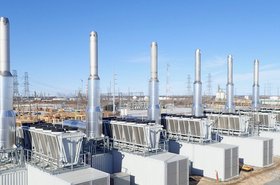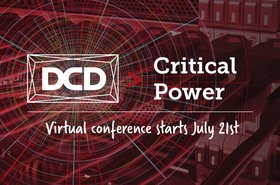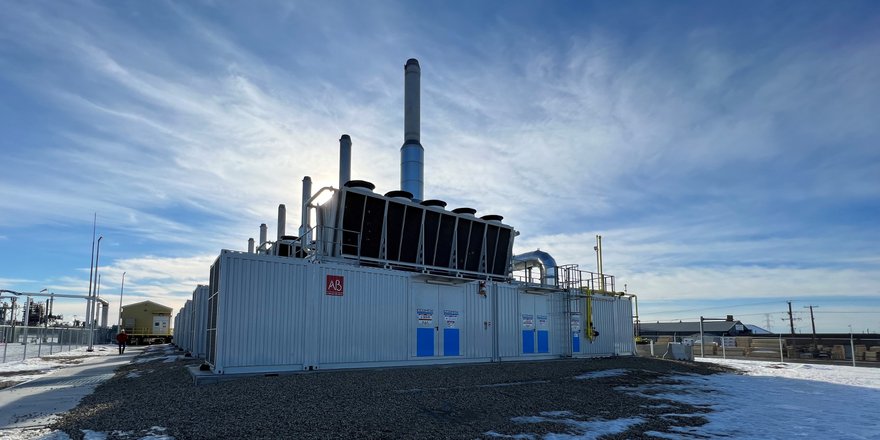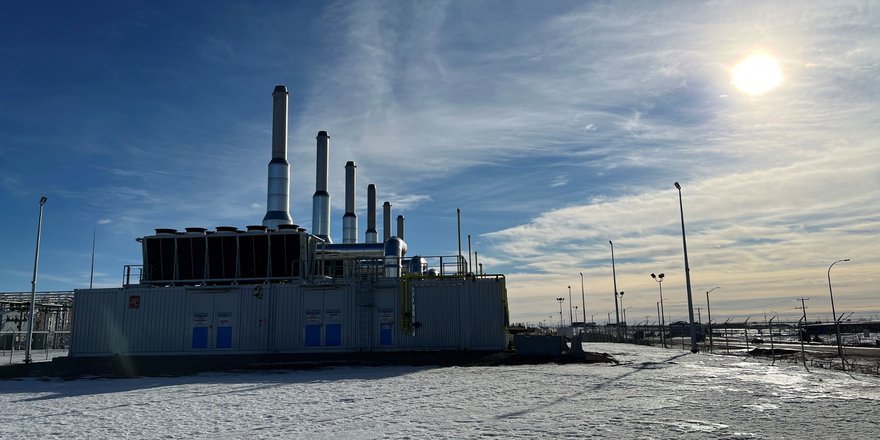Jan Buijk is CEO of AB Energy Canada, part of the Italian energy group that focuses on highly efficient gas engine power plants for the data center and other industries. But Buijk is more than ‘just’ a CEO: a company founder, he has a technical background in mechanical engineering with an in-depth knowledge of combined heat and power technology, and was responsible for establishing AB Energy in North America.
DCD’s head of partner content, Graeme Burton, spoke to Buijk about the advantages of migrating to gas-fired generation from diesel, the effect of gas-price volatility on power markets, trigeneration and green hydrogen.
DCD – What are the particular advantages of gas over diesel for backup power generation?
Jan Buijk, AB Energy – The primary advantages are, first of all, gas engines have a significantly lower emission profile compared to diesel. That means nitrogen oxides, particulates, volatile organic compounds CO and CO2. So there are significant environmental advantages of natural gas-fired generation compared to diesel.
Second, fuel costs for natural gas fired generators are generally quite a bit lower than diesel, and there's no need for fuel storage on-site. Furthermore, a number of studies have demonstrated that natural gas infrastructure, in many jurisdictions, is far more reliable than diesel, especially during events like a prolonged utility outage. When there's a large area without power, such as in Texas in February 2020, then it becomes much more difficult to supply diesel to critical facilities.
And, third, running on natural gas, you can turn your power plant into the primary source of power for your data center and the grid can then become the backup, as it is in many regions around the world. Indeed, natural gas fired generation is cleaner than the power provided by the grid in many areas, and there's areas where the grid cannot reliably supply all the power required.
Then, once you're looking at natural gas as a primary source of power, there's also an opportunity to generate incremental revenues by, for example, making equipment available for demand-response programmes or during events where power prices are high when you can also export power back to the grid.
DCD – What about the costs? First, of the gas engines themselves; second, their maintenance and upkeep; and, third, the cost of the fuel?
The cost of building natural gas fired power plants is higher than the cost of a diesel fired power plant. So, there has to be a justification for the higher cost and that can be found in lower operating costs – lower fuel costs – but in order to achieve those lower costs in the long run you have to actually run the machines.
If it's purely a standby power plant that only runs in the event of a utility outage, it will be nearly impossible to justify the use of natural gas over diesel on cost grounds, although it makes plenty of sense in terms of improved sustainability.
But you can achieve cost benefits as well, if you have a way to operate the plant. So, if the utility can’t deliver all the power required, you should ask what the most cost-effective way of getting power to the facility is. Used regularly, natural gas clearly outperforms diesel.
If you have an opportunity to participate in demand response, to export power, that’s another way to lower the lifecycle cost and generate some bonus revenues with a gas power plant.
And one possibility that should not be overlooked is that it is possible for a third party to own the power plant and sell the electricity back to the data center, which means that rather than making a significant upfront investment, you now remove an entire cost-line from the data center development and it now becomes an energy services contract.
DCD – what about the expertise required to look after it? Does it require particular expertise? Or can the same guys who looked after your diesel backup power plants actually do the same job with gas
On-site, the requirements are the same, whether an operator is looking after diesel plant or natural gas. It's very similar, but maintenance requires a specialized services team. That’s actually one of the key focus points of our company: not only to offer a standardized modular design, but to have a global services infrastructure team of more than 300 service technicians. They have the tools, the vehicles, the people, and the parts to support these plants, and to make sure that they perform as intended. Service support is always super-critical for projects like this.
DCD – How does the current volatility in global gas prices affect the case that you're making for gas?
It definitely sucks. There's no question that volatility creates uncertainty, and uncertainty makes it more difficult to demonstrate the long-term financial advantages for gas-fired generation. It does not help, but it’s no different to the market for diesel fuel or, indeed, electricity over the past year.
DCD – While gas is considerably cleaner than diesel it does still have some emissions. What further measures can be taken to reduce emissions still further, for example, in terms of filters and other emission control systems?
There are some emission control systems built-in. You can work with SCR sytems and catalysts to remove some of the contaminants from the exhaust flow – specifically things like NOx, carbon monoxide and particulates. That is a means of reducing the actual emissions from the engines themselves. Then there is also the opportunity to do something with the gas going into the engine.
There’s also potential to blend-in hydrogen or even to have engines running on 100 percent hydrogen. Indeed, many of the engines that we are delivering to customers today can be modified and can accommodate up to 25 percent hydrogen to be blended in, resulting in a significant reduction of CO2 and other emissions.
But one thing that is often overlooked is that with renewable natural gas (RNG) or biomethane you can go carbon neutral right now. Globally, we see a huge movement towards decarbonizing the natural gas supply, incredible investments are being made to convert increasing amounts of organic waste via anaerobic digestion into biogas and, in turn, upgrade biogas into RNG.
In North America, we typically refer to it as RNG and in Europe as biomethane, but it’s both the same stuff – biogas produced through an anaerobic digester. It could be from a dairy farm, a food processing plant, municipal organic waste. It could be from a landfill site. You can remove contaminants, CO2 and then you end up with, essentially, pure methane, which can be injected into the natural gas pipeline infrastructure.
As a data center operator, you can sign contracts to run on biomethane. There are no changes to your equipment, and nothing changes to the natural gas infrastructure. You are now, however, now running carbon neutral. Yeah, because the natural gas that you are combusting is in fact, offset by the RNG that is injected elsewhere in the in the natural gas blank infrastructure.
DCD – If you're installing gas for backup in place of diesel, what changes does that mean in terms of the rest of your business continuity infrastructure?
Diesel is typically pretty much a diesel engine in a box. In our case, it's a gas engine in a box, which we bring to market under the Ecomax brand name. It's a containerized solution where, instead of a diesel connection, it's a natural gas connection at the wall. Electrically, where you're connecting to the generator terminals and the switchgear, the transformers, the infrastructure outside of the containers, they are all pretty much the same.
So, other than the fact that you're connected to the natural gas infrastructure for fuel versus having a diesel tank farm and managing that diesel fuel, there's really not that much in the infrastructure itself that is dramatically different.
DCD – If you're using an on-site gas engine for primary power, how easy is it to scale it up according to need?
It’s basically a case of scaling up multiple containerized units. In theory, we can scale up to almost any power plant size required: as long as the space is there, you can you can add more modules. The largest one we offer is 4.4MW, but our solutions fit best anywhere between five and 50MW, where you’d be looking at as many as 10-to-12 containerized units.
DCD – So, how does trigeneration work and what are the benefits?
This could create incremental benefits for our customers and data centers.
When you run all-natural gas engines today about 45 percent to 50 percent of the energy that goes in comes out in the form of electricity and the other half is available as heat. So, if you look at it as a system, about half of the energy coming out is electricity. So you might ask, ‘How can I improve overall system efficiency?’
Data centers typically have more excess heat already than they know what to do with, but do need cooling. This is where it is possible to capture that heat from both the engine coolant as well as from the engine exhaust and then utilize this heat for what is called absorption cooling.
By utilizing absorption cooling you can now capture all that heat and use it to generate cooling, enabling you to improve the efficiency of the system from maybe 45 percent to as much as 85-to-90 percent. Now, you have a significant amount of cooling that's available to the data center.
Similar to our standardized containerized modular systems for power generation, we have also developed a line-up of standardized absorption cooler modules. It's not just the absorption chiller itself, but all the controls around it, the cooling tower, all the pumps and infrastructure around it, but in a box designed to match-up with our power generation modules, which can also be scaled up as required for various projects.
So, again, it’s a standardized modular design with the power generation, heat recovery, and absorption cooling that can help further optimize the use of gas engines in data center applications.
DCD – Final question, there's been a lot of talk about green hydrogen. If such a technology does go mainstream, how easy is it to repurpose gas engines? And if you can repurpose them of course what are the kind of modifications to the power and backup systems that might be required?
Hydrogen has been in the sights of engine manufacturers, including Innio Jenbacher, the engine manufacturer we work with at AB Energy, for the past two or three decades. Innio, for example, has been operating engines on various blends of hydrogen-based fuels for a number of years.
Gas from gasification is a good example. Biomass gasification fuels tend to have a hydrogen content that is somewhere in the 10 percent to 15 percent range. So there's already significant expertise out there on operating engines with hydrogen-containing fuels. This is also where, today, many of the engines that we bring to market can relatively simply be converted to a blend of hydrogen and natural gas.
So, blending in up to 25 percent hydrogen is something that we can commit to today. There's also some smaller engines in the 1MW-range capable of running on 100 percent hydrogen available today. As time goes by, we would expect that more hydrogen-capable engines will become available, readily capable of operating on 100 percent hydrogen.
To learn more about AB’s on-site power plants for data center applications, please visit www.gruppoab.com or contact [email protected].
More...
-

Sponsored AB Energy: Modular gas engine power plants for data center applications
AB Energy is the new kid on the block with more than 40 years’ experience building high efficiency, low emission, pre-engineered power plants
-





